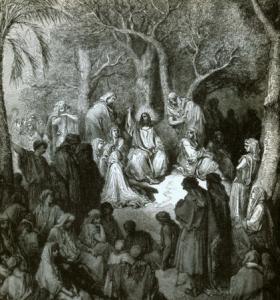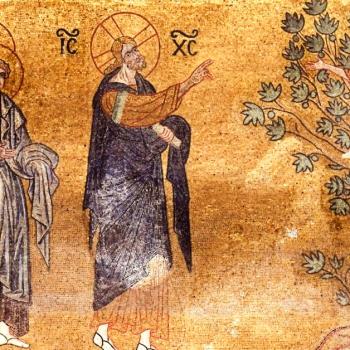
The Sermon on the Mount in the gospel of Matthew reveals not only Jesus’ teachings, but how he modeled discipleship. By simply observing how he interacted with those closest to him, we can gain powerful insights into how we can share our lives to transform the world around us one relationship at a time.
It’s Not Complicated
I remember going through the Sermon on the Mount from the perspective of discipleship with the last congregation I pastored. It was a group of people who were a diverse mixture of churched couples and individuals who viewed the church as an institution, along with people who were new to faith and whose primary connection was entirely relational.
The way we moved forward scripturally happened in an organic, non-scholarly way. Check this out:
“Now when Jesus saw the crowds, He went up on a mountainside and sat down. His disciples came to Him, and He began to teach them…” (Matthew 5:1-2, NIV)

The crowds were there following Jesus from all over, even very far away, because he was teaching in the synagogues, proclaiming the good news, and healing. But notice the scripture I presented above says that when he sat down his disciples came to him, and he began to teach them.
When I wrote “non-scholarly way” above, I was talking about the very clear presentation of the verse. Jesus was on a mountain or hillside near the Sea of Galilee, perhaps in the vicinity of Capernaum. It doesn’t state that he began preaching to the multitudes. It says he was teaching them.
But who are them?
Does “them” mean everybody, the disciples and the crowd? Well, no, that isn’t what the verse actually says. It says his disciples came to him, and he began to teach them.
Imagine with me just the simplicity of what the scripture presents: Jesus saw all these people following him around, and so he went up the side of a mountain or hill and sat down. It also sounds like he got ahead of the crowd, because it specifies that his disciples “came to him” instead of saying “the crowd followed him up the side of the mountain.” So, it doesn’t exactly state the crowd remained at the bottom of the hill, but it does imply a distinction between the crowd and the activities of his disciples.
Check out how Eugene Peterson’s The Message paraphrases that passage:
“When Jesus saw his ministry drawing huge crowds, he climbed a hillside. Those who were apprenticed to him, the committed, climbed with him. Arriving at a quiet place, he sat down and taught his climbing companions.” (Matthew 5:1-2, MSG)
Oh, okay, let’s get just a little more technical.
More Than Words
What we have in this passage is the very first occasion the word “disciples” was ever used. In fact, it was so novel to find the Koine Greek word “μαθηταὶ” that we translate as “disciples” in the text, it has left people scratching their heads ever since.
I don’t mean to imply that “disciples” is anything less than a fine and accurate translation, but opinion has been divided whether it numbered just a very few, like maybe the less than the Twelve (because not all the Twelve had been selected yet), or whether it could have had a broader meaning. John Wesley unfortunately supported the idea that “disciples” and “them” was many more than just the few apostles Jesus had already chosen. And importantly, intertextual evidence such as Matthew 7:28 reveals that the crowd at the very least could overhear what Jesus was saying.
On the other hand, many scholars (including Augustine) believe that the language in context immediately would indicate by construction that it was referring to the small number of disciples whom Jesus had just selected a few verses earlier. Additionally, this discourse is the sole occasion in the gospel of Matthew where Jesus is described “teaching.”
Custom would indicate that if Jesus was sitting, (especially after he noticed the crowds and decided to climb a mountain), the teaching was more intimate. I mean, usually, when people address a crowd—especially in times where all amplification was exclusively acoustic—speakers tend to stand. Oh, you know, it elongates the diaphragm, and all that other good stuff because for everyone to hear, you must raise your voice. Yet Jesus sat.

When you add it all up, the passage just doesn’t say a sermon was preached to a crowd, it says Jesus taught His disciples.
Why is this important?
Because if Jesus was demonstrating discipleship to a few by modeling it before a crowd, then the awesome teaching we know as the Sermon on the Mount isn’t some great oratory achievement delivered to the masses, but an intimate teaching from the Messiah to the few people he trusted most. It’s a heartfelt lesson from a Rabbi to his devoted students, given in front of a great crowd.
So, if you then consider the passages of the Sermon on the Mount topically, like “salt and light,” or “anger” or “lust” or “giving” or “fasting” or “judging others,” within the context of an intimate, personal lesson, it could impact how we understand the teaching. Changing the intended audience from strangers to close friends also changes the context to that of a conversation. A dialogue, rather than a monologue.
Here’s what I mean: if you were kicking back having coffee with Jesus, and he personally began to disciple you on lust (for example), what would he say?
Discipleship Must Be Relational
Jesus was talking to people he knew—he knew what made them tick, not only because he was who he is, but because he had shared his life with them, and they with him.
And when I think about Jesus modeling this teaching method before thousands, it floods my mind with the consistency of his great commission to his disciples:
“…Go and make disciples of all nations, baptizing them in the name of the Father and of the Son and of the Holy Spirit, and teaching them to obey everything I have commanded you. And surely I am with you always, to the very end of the age.”(Matthew 28:19-20, NIV)
It magnifies each of the teachings Jesus made in the Sermon on the Mount. How can we take these words of Jesus himself, spoken as he would speak to a close friend, and pass this teaching on to others?

First, Christ’s method was intimate discipleship. The healings, the works—that’s what the crowds saw—but the disciples experienced his life, the nitty gritty human source of where his personal teaching came from. By eating, sleeping, walking, and talking, he more than just shared his life, Jesus lived his life with his disciples.
So, what should be our response?
In the years since I last worked with an entire congregation through the Sermon on the Mount, I have had a few opportunities to have a discipling conversation with others (not a crowd by any definition) about what Christ was communicating on a personal level. I remember asking, “How can we pass this teaching on to others in our lives who need to hear it?”
Invariably, the answer many offer automatically without hesitation is to pray. And without diminishing the importance of prayer, it is a limited representation of the discipling actions Jesus modeled.
What I pray for myself and for you is that we seek opportunities to do exactly what Jesus did: find moments and ways to share our lives with others, and by doing that, our lives even more than our words may be used to transform lives and make Christlike disciples.














